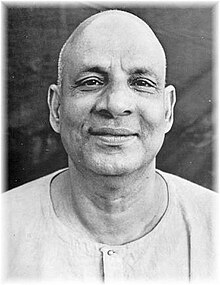Loading AI tools
Hindu spiritual teacher From Wikipedia, the free encyclopedia
Swami Sivananda Saraswati (IAST: Svāmī Śivānanda Sarasvatī; 8 September 1887 – 14 July 1963[1]), also called Swami Sivananda, was a yoga guru,[2] a Hindu spiritual teacher, and a proponent of Vedanta. Sivananda was born in Pattamadai, in the Tirunelveli district of modern Tamil Nadu, and was named Kuppuswami. He studied medicine and served in British Malaya as a physician for several years before taking up monasticism.
Sivananda Saraswati | |
|---|---|
 | |
| Personal | |
| Born | Kuppuswami 8 September 1887 |
| Died | 14 July 1963 (aged 75)[1] |
| Religion | Hinduism |
| Nationality | Indian |
| Organization | |
| Founder of | Divine Life Society |
| Philosophy | Yoga of Synthesis |
| Religious career | |
| Guru | Vishwānanda Saraswati |
Be Good, do Good, be kind, be compassionate.
He was the founder of the Divine Life Society (DLS) in 1936, Yoga-Vedanta Forest Academy (1948) and author of over 200 books on yoga, Vedanta, and a variety of subjects. He established Sivananda Ashram, the headquarters of the DLS, on the bank of the Ganges at Muni Ki Reti, 3 kilometres (1.9 mi) from Rishikesh, and lived most of his life there.[3][4][5]
Sivananda Yoga, the yoga form propagated by his disciple Vishnudevananda, is now spread in many parts of the world through Sivananda Yoga Vedanta Centres. These centres are not affiliated with Sivananda's ashrams, which are run by the Divine Life Society.
Swami Sivananda was born as Kuppuswami to a brahmin family[6] on 8 September 1887. His birth took place during the early hours of the morning as the Bharani star was rising in Pattamadai village on the banks of the Tamraparni river in Tirunelveli district, Tamil Nadu. His father, Sri P.S. Vengu Iyer, worked as a revenue officer, and was a great Shiva Bhakta (Bhakti) himself. His mother, Srimati Parvati Ammal, was religious. Kuppuswami was the third and last child of his parents.[7][8]
As a child, he was very active and promising in academics and gymnastics. He attended medical school in Tanjore, where he excelled. He ran a medical journal called Ambrosia during this period. Upon graduation, he practiced medicine and worked as a doctor in British Malaya for ten years, with a reputation for providing free treatment to poor patients. Over time, a sense that medicine was healing on a superficial level grew in Dr. Kuppuswami, urging him to look elsewhere to fill the void, and in 1923 he left Malaya and returned to India to pursue his spiritual quest.[7]
Upon his return to India in 1924, he went to Rishikesh where he met his guru, Vishvananda Saraswati, who initiated him into the Sannyasa order, and gave him his monastic name. The full ceremony was conducted by Vishnudevananda, the mahant (abbot) of Sri Kailas Ashram.[7] Sivananda settled in Rishikesh, and immersed himself in intense spiritual practices. Sivānanda performed austerities for many years while continuing to nurse the sick. In 1927, with some money from an insurance policy, he ran a charitable dispensary at Lakshman Jhula.[7]
Sivananda founded the Divine Life Society in 1936 on the banks of the Ganges River, distributing spiritual literature for free.[7] Early disciples included Satyananda Saraswati, founder of Satyananda Yoga.
In 1945, he created the Sivananda Ayurvedic Pharmacy, and organised the All-world Religions Federation.[7] He established the All-world Sadhus Federation in 1947 and the Yoga-Vedanta Forest Academy in 1948.[7] He called his yoga the Yoga of Synthesis, combining the Four Yogas of Hinduism (Karma Yoga, Bhakti Yoga, Jnana Yoga, Rāja Yoga), for action, devotion, knowledge, and meditation respectively.[9]
Sivananda travelled extensively on a major tour in 1950, and set up branches of the Divine Life Society throughout India. He vigorously promoted and disseminated his vision of yoga.[10] His Belgian devotee André Van Lysebeth wrote that his critics "disapproved of both his modern methods of diffusion, and his propagation of yoga on such a grand scale to the general public", explaining that Sivananda was advocating a practice that everybody could do, combining "some asanas, a little pranayama, a little meditation and bhakti; well, a little of everything".[10][11]
Sivananda insisted on a strict lacto-vegetarian diet for moral and spiritual reasons, arguing that "meat-eating is highly deleterious to health".[12][13][14][15] Divine Life Society thus advocates a vegetarian diet.[15]
Swami Sivananda died, described as entering Mahasamadhi, on 14 July 1963 beside the River Ganges at his Sivananda Ashram near Muni Ki Reti.[1]
Sivananda's two chief acting organizational disciples were Chidananda Saraswati and Krishnananda Saraswati. Chidananda Saraswati was appointed president of the DLS by Sivananda in 1963 and served in this capacity until his death in 2008. Krishnananda Saraswati was appointed General Secretary by Sivananda in 1958 and served in this capacity until his death in 2001.
Disciples who went on to grow new organisations include:
Seamless Wikipedia browsing. On steroids.
Every time you click a link to Wikipedia, Wiktionary or Wikiquote in your browser's search results, it will show the modern Wikiwand interface.
Wikiwand extension is a five stars, simple, with minimum permission required to keep your browsing private, safe and transparent.